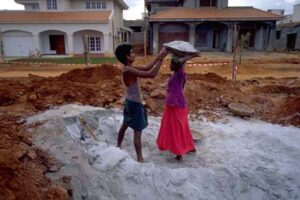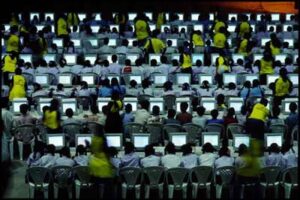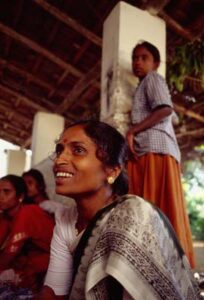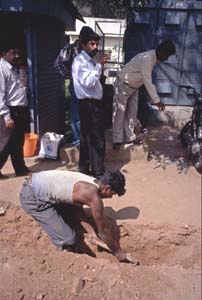David Wells
- 2001

Fellowship Title:
- Can India Reconcile its Past with its Future?
Fellowship Year:
- 2001

Beyond Stereotypes: Globalization’s Winners and Losers
To discuss the winners and losers in globalization in developing nations such as India, most people reach for a cliché. “The rich get richer and the poor get poorer” is a widely held misnomer about globalization. Well-documented declines in poverty in poorer countries that are integrating into the global economy argue to the contrary. Research further shows that globalization reduces poverty generally, since more globally integrated economies grow faster. At the dedication of an addition to a Hindu temple in the Ulsoor neighborhood of Bangalore, India, a wealthy donor (L) talks to the temple’s priest (R) while proudly sporting a T-shirt with a Western logo. For each story about growing upper class wealth there is a story about improvement in the lives of the poor. For example, there are India’s new high tech yuppies, some who made more money in the ’90s than their families earned in the previous millennia. At the same time, there was progress in places like Vietnam, which cut its poverty rate by 50%. Uganda cut its poverty rate by 40%

Gateways of India’s Globalization
Globalization is hardly a new force affecting India. To think so is to ignore a diverse and pluralistic long-standing civilization that was shaped by a long list of “invading” (globalizing) cultures that became what we now know as India. The previous globalizers of India include the Aryans, Hindus, Dravidians, Greeks, Buddhists, Turks, Afghans, Scythians, Muslims and most recently, the Europeans, Portuguese, French, Dutch and finally the English. One has to understand that as India has been globalized it has also been a globalizer too, with millennia of colonialism across Southeast Asia, with temples like Angkor Wat left behind as a reminders of India’s one time presence. Long viewed by the West, as “poor and impoverished,” to its neighbors such as Sri Lanka, Bangladesh and Pakistan, India is wealthy and powerful. To these smaller neighbors, India is a great power, a globalizer of its own, which expects deference from them and is sometimes angered when those nations downplay their Indian lineage. They prefer to play up their own local cultures, which are frequently hybrids of the

The Dichotomies in Indian Women’s Lives
For every truth you find in India, the opposite is equally true. This well-worn cliché is doubly true when looking at the lives of Indian women. Indira Gandhi’s rule as Prime Minister of India, for example, was a triumph for women in leadership, yet the nation under her rule was populated by hundreds of millions of impoverished women, whose lives changed remarkably little during her term. In the 1990s, India had one of the highest number of international beauty contest winners and one of the lowest rates of female literacy in the world. Maternal mortality rates in some rural areas of India are among the worst in the world, yet India has the world’s largest number of professionally qualified women, with more trained female doctors, surgeons, scientists and professors than the United States. In the village of Minijenahalli in the Kolar district of the southern Indian state of Karnataka, a group of poor and middle class village women meet. Unlike other states, the number of women elected to the rural Panchayits and similar urban councils

Milestones: A Road Map to the Indian Middle Clas
India, a country stereotyped for its vast number of poor, also is home to what many consider to be the world’s largest middle class. The very size and population of India tends to obscure everything else about the country. For example, India, a nation stereotyped as famine stricken, last was devastated by a famine in 1943, before independence, when India was still ruled by the British. When the British finally left India in 1947, they fled a partitioned country wracked by war and dislocation. They also left behind the rule of law, democracy, an independent judiciary, a free press, railways, canals, and harbors. They introduced modern education and helped create a small middle class. A manual laborer digs a trench next to a stand selling coffee to government bureaucrats and office workers in Bangalore, the fastest growing Indian city with the largest population of middle class. Laborers are laying fiber optic cable to update the city’s infrastructure. Often referred to as India’s Silicon City, Bangalore is home to over 300 software companies and 150 high-tech
